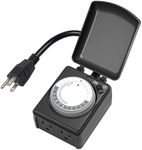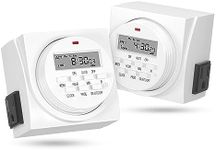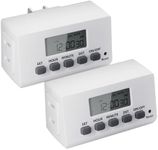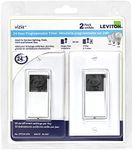Buying Guide for the Best Light Timer Switch
Choosing a light timer switch can make your home more convenient, energy-efficient, and secure. These devices automatically turn your lights on or off at set times, which is great for automating routines or making your home look occupied when you're away. To find the best fit, it's important to understand the main features and how they relate to your needs, such as the type of lights you have, how many settings you want, and how easy the switch is to use.Type of Timer (Mechanical vs. Digital)The type of timer refers to whether the switch uses a mechanical dial or a digital interface. Mechanical timers are simple, with a physical dial you turn to set the time, and are usually very straightforward to use. Digital timers offer more precise control, often with programmable schedules and extra features like randomization. If you want basic on/off control, a mechanical timer is usually enough. If you need more flexibility, like different schedules for weekdays and weekends, a digital timer is a better choice.
Programming OptionsProgramming options describe how many different on/off times you can set and how flexible the scheduling is. Some timers only allow one on and one off time per day, while others let you set multiple events or different schedules for each day of the week. If your routine is the same every day, a simple timer will work. If your schedule changes or you want to control lights differently on weekends, look for a timer with more advanced programming.
Compatibility with Light TypesNot all timer switches work with every type of light bulb or fixture. Some are only compatible with incandescent bulbs, while others can handle LEDs, CFLs, or even low-voltage lighting. It's important to check what kind of lights you have and make sure the timer switch supports them. If you use energy-saving bulbs like LEDs, make sure the timer is rated for those to avoid flickering or malfunction.
Load CapacityLoad capacity is the maximum amount of electrical power the timer switch can handle, usually measured in watts or amps. This is important because using a timer with a load higher than it can handle can be unsafe. To choose the right one, add up the wattage of all the lights or devices you plan to control with the timer and make sure it's below the switch's maximum rating.
Ease of InstallationEase of installation refers to how simple it is to set up the timer switch. Some models plug directly into a wall outlet and require no wiring, while others replace your existing wall switch and may need some basic electrical work. If you're comfortable with DIY projects, a hardwired switch might be fine. If not, look for a plug-in model or consider hiring a professional for installation.
Manual Override FeatureA manual override lets you turn the lights on or off without changing the timer settings. This is useful if you want to use the lights outside of the programmed schedule without having to reprogram the timer. If you want flexibility to control your lights at any time, make sure the timer has this feature.
Display and ControlsThe display and controls affect how easy it is to set and adjust the timer. Digital timers often have screens and buttons, while mechanical ones use dials or switches. If you prefer a simple setup, a mechanical timer is usually easier. If you want more control and don't mind a slightly steeper learning curve, a digital timer with a clear display is a good choice.

















